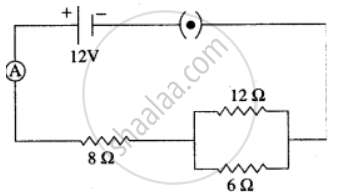Advertisements
Advertisements
Question
100 joules of heat is produced per second in a 4 ohm resistor. What is the potential difference across the resistor?
Solution
Given R = 4 Ω
H = 100 J
t = 1 s
We know that, H = I2Rt
`rho=H/Rt=100/(4xx1)=25A^2`
I = 5 A
Now: V = I
V = 5 x 4 = 20 V
APPEARS IN
RELATED QUESTIONS
What is a voltmeter?
What current will be taken by a 920 W appliance if the supply voltage is 230 V?
Calculate the power used in the 2 Ω resistor in each of the following circuits: a 4 V battery in parallel with 12 Ω and 2 Ω resistors.
The differences between the electrostatic potential of the positive end the negative end of an electric cell is the ______ of the cell.
A current of 0.2 A flows through a wire whose ends are at a potential difference of 15 V. Calculate:
(i) The resistance of the wire, and
(ii) The heat energy produced in 1 minute.
Three resistors are connected to a 12 V battery as shown in the figure given below:

(i) What is the current through the 8 ohm resistor?
(ii) What is the potential difference across the parallel combination of 6 ohm and 12 ohm resistor?
(iii) What is the current through the 6 ohm resistor?
An electric bulb draws 0.5 A current at 3.0 V. Calculate the resistance of the filament of the bulb.
100 J of heat is produced each second in a 4 Ω resistor. The potential difference across the resistor will be:
Find out the following in the electric circuit given in Figure
- Effective resistance of two 8 Ω resistors in the combination
- Current flowing through 4 Ω resistor
- Potential difference across 4 Ω resistance
- Power dissipated in 4 Ω resistor
- Difference in ammeter readings, if any.

Name a device that helps to maintain a potential difference across conductors.
